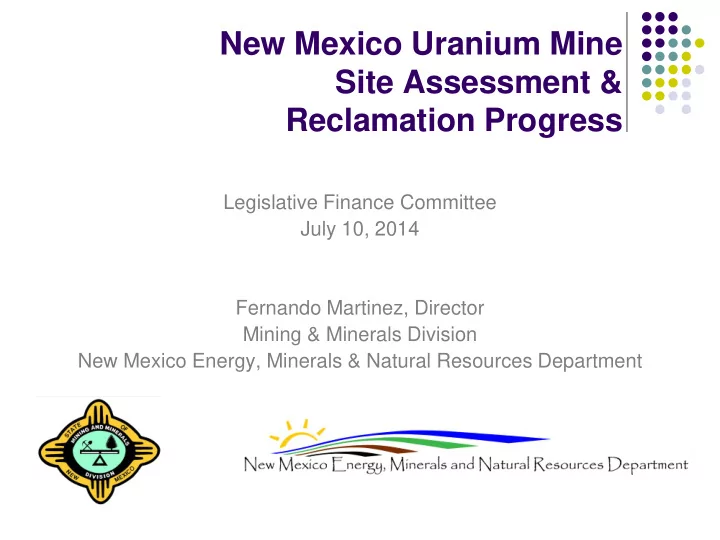

New Mexico Uranium Mine Site Assessment & Reclamation Progress Legislative Finance Committee July 10, 2014 Fernando Martinez, Director Mining & Minerals Division New Mexico Energy, Minerals & Natural Resources Department
Project Phases Literature review & data collection Data collection from digital imagery Field surveys & site assessments Schmitt Ranch decline Site prioritization Reclamation design Leveraging resources & partnerships Remediation, reclamation & clean-up St. Anthony open pit
Literature Review & Data Collection Developed an inventory of abandoned uranium mines (AUMs). Identify recorded reclamation status of all mines in inventory. Sources: New Mexico Bureau of Geology and Mineral Resources o publications, State Mine Inspector records, o Atomic Energy Commission records, o Mining and Minerals Division records, o Bureau of Land Management surveys, o Navajo Nation AUM Atlas, o U.S. EPA data, and o Other publications. o
Abandoned Uranium Mine Inventory
AUM Inventory Statistics All All AUMs, AUMs No Documented Reclamation Number of mines 259 137 Production >20 million 1 0 (lbs. U 3 O 8 ) 2 million-20 million 24 3 200,000-2 million 28 10 20,000-200,000 35 19 < 20,000 131 85 included with other mines 40 20 Surface Federal 68 48 ownership Private 78 46 State 9 9 Tribal, trust 77 16 Tribal, allotment 17 16 Mixed 10 2
Field Surveys Project assessment and maintenance of previous New Mexico Abandoned Mine Land (AML) projects. Surveyed 14 mines in the Poison Canyon and Ambrosia Lake areas north of Milan and 1 mine located southeast of Gallup. 2008 federal and state lands field survey. Industry-sponsored survey of 21 mines on Federal and State lands located throughout New Mexico. 2009 survey and engineering design contract. AML professional services contract for surveying, site assessment and reclamation design for 7 mines in the Poison Canyon area. 2009 field survey. Request for proposals for preliminary site assessment and field survey work for approximately 25 mines located throughout New Mexico.
AML Project Assessment & Maintenance The New Mexico Abandoned Mine Land (AML) Program safeguarded 15 abandoned uranium mines in the early 1990s. Mines were surveyed from summer 2007 to summer 2008 to assess the need for maintenance and to identify proximity waste piles. Beacon Hill Gossett mine
2008 Federal & State Lands Field Survey
2009 Survey & Engineering Design Contract Current AML Program professional services contract covering 7 mines on state, federal and private lands in the Poison Canyon area. Contract covers site assessment and survey work, followed by the development and engineering of clean-up plans for these sites. T-20 mine
Radiation Reading Sampling
2009 Field Survey Request for Proposals for geo-environmental site assessment services at abandoned uranium mine lands located throughout New Mexico Funding of $200k from federal abandoned mine land grant monies and from 2009 appropriation of state Mining Act penalty monies fund. Spencer mine
Site Prioritization Limited resources require prioritizing abandoned uranium mine sites. Multi-agency involvement on federal, state and tribal levels. Priority based on site factors. Radiological hazards o Physical safety hazards (open shafts & adits, o subsidence, high walls) Proximity to homes o Proximity to domestic wells o Proximity to water drainages o
Reclamation Design Joint project of the New Mexico & Navajo Nation Abandoned Mine Land Programs
Leveraging Resources & Partnerships
Remediation, Reclamation & Clean-Up Continued coordination with federal, state and tribal agencies. Perform further site assessment and radiological surveys. Prioritize sites. Establish reclamation standards and criteria. Promote public participation. Secure funding sources for cleanup work: federal, state, tribal and private sources.
Recommend
More recommend